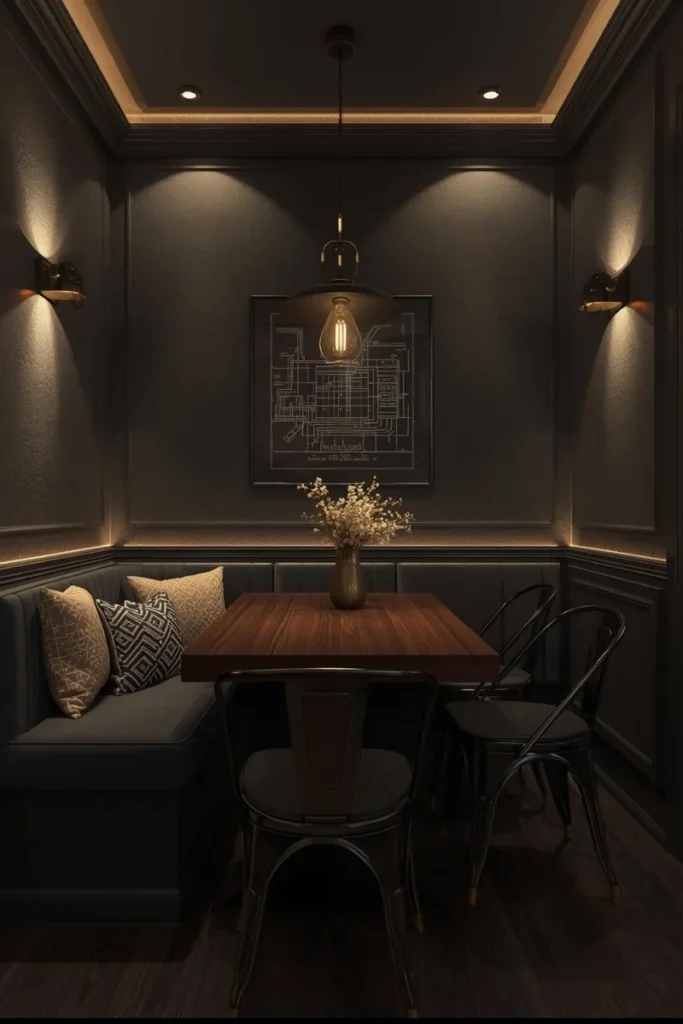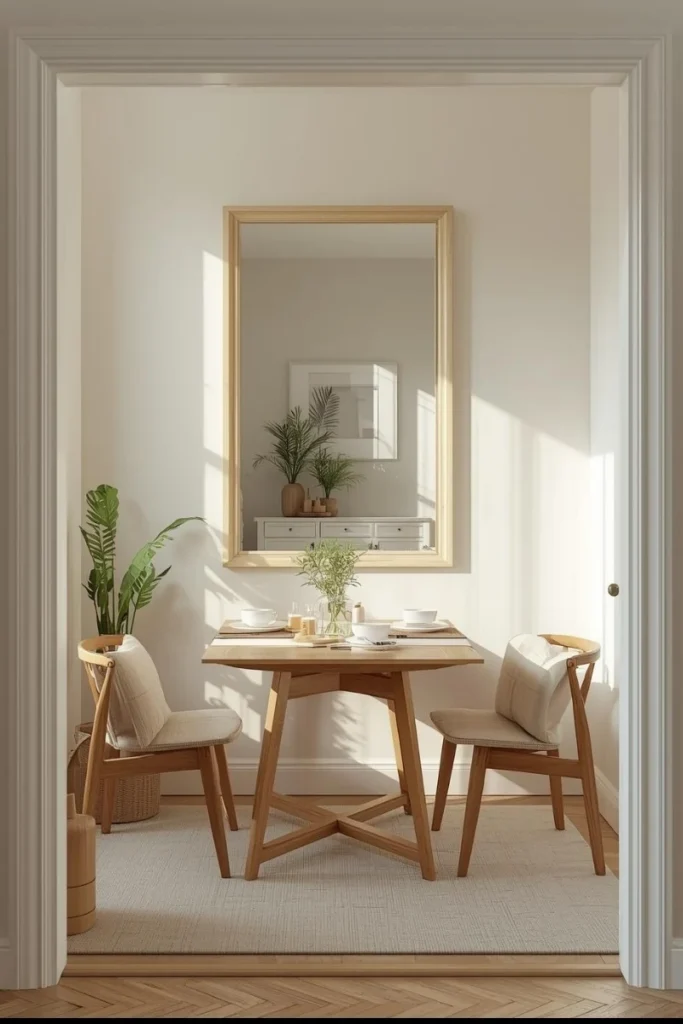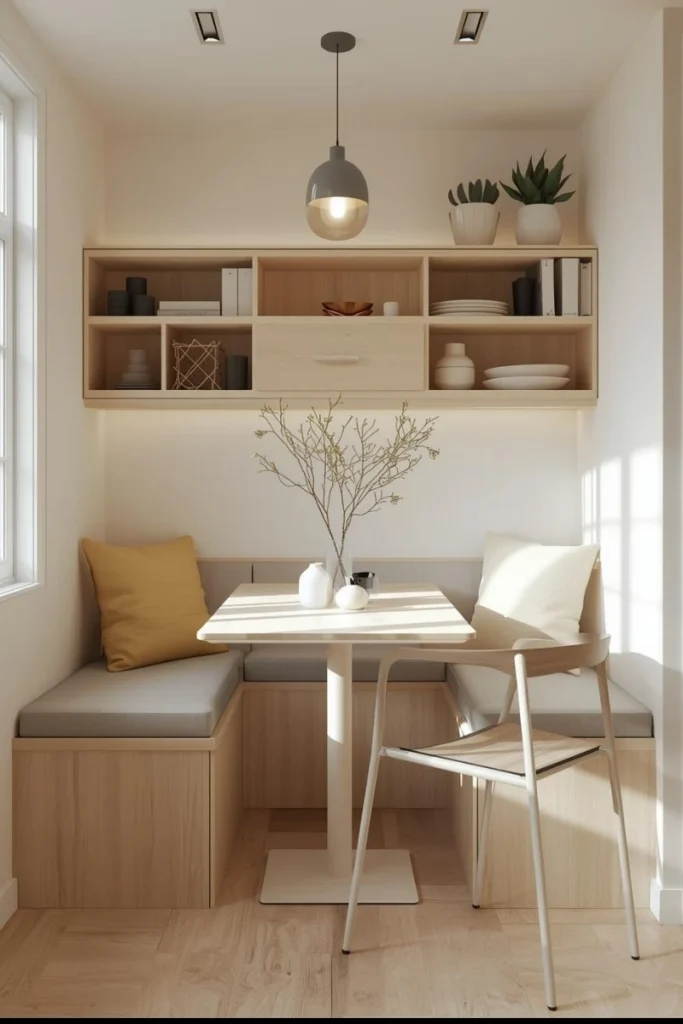20 Smart Small Dining Room Hacks for Maximum Comfort

Introduction
Designing a small dining room can feel like a challenge, but with the right approach, it’s easy to create a space that’s both stylish and highly functional. The key lies in smart planning, clever furniture choices, and practical décor solutions that maximize comfort without overcrowding the room. From space saving layouts to multifunctional pieces, small dining room ideas help transform even the most compact area into a welcoming and efficient space for meals and gatherings.
By focusing on proportion, flow, and practical details, a small dining room can feel open, airy, and inviting. Thoughtful hacks—like using foldable tables, bench seating, or mirrors to expand the perception of space allow you to enjoy functionality without sacrificing style. Every choice, from lighting to wall colors, plays a role in enhancing both comfort and aesthetics, creating a room where every meal feels special.
With these smart small dining room hacks, you can combine creativity and practicality to make the most of limited space. Whether your style is modern, rustic, or eclectic, these ideas show that compact dining areas can be cozy, elegant, and incredibly functional, making them a true highlight of your home.
1. Opt for a Foldable or Extendable Table

In small dining rooms, every inch of space matters, which makes foldable or extendable tables a smart choice. These tables remain compact when not in use, freeing up floor space and creating a sense of openness. When guests arrive, simply extend the table to accommodate more seating. Modern designs come in sleek finishes and versatile shapes, seamlessly blending style with practicality.
Functionally, extendable tables allow you to host meals or gatherings without permanently occupying valuable square footage. They adapt to changing needs, whether it’s a quiet breakfast for two or a dinner party with friends. This flexibility makes your dining area highly functional while keeping it stylish and uncluttered.
2. Use Bench Seating Along One Side

Replacing traditional chairs with benches along one wall is a clever way to save space. Benches tuck neatly under the table when not in use, opening up circulation and creating a cleaner look. They also allow more people to sit in a limited area, making them ideal for compact dining rooms. Upholstered benches add comfort, while wooden or metal designs enhance style and durability.
From a practical standpoint, benches are versatile—they can double as extra storage if they have built-in compartments underneath. They provide flexible seating for gatherings without crowding the room and can be paired with a mix of chairs on the other side for a balanced, dynamic layout.
3. Go Vertical with Wall Storage
In small dining rooms, floor space is precious, so vertical storage is a lifesaver. Open shelves or wall-mounted cabinets can store dishes, glasses, or décor items without taking up floor area. Floating shelves also allow you to display attractive tableware, cookbooks, or small plants, adding personality to the space.
Functionally, vertical storage keeps essentials within reach while reducing clutter on the table and countertops. It also draws the eye upward, giving the room a taller, more open feel. By making use of walls, you maximize storage and maintain a clean, organized, and stylish dining area.
4. Choose Light Colors for Walls and Furniture

Light colors instantly make a small dining room feel brighter and more spacious. Soft whites, creams, and pale grays reflect natural light, creating a sense of openness. Pairing light walls with furniture in similar shades enhances the airy effect, while accent pieces in bold or metallic tones add depth and visual interest.
From a practical perspective, a light palette is versatile and timeless. It allows you to update accessories seasonally or change your décor style without repainting or replacing major furniture pieces. The result is a compact dining space that feels open, elegant, and welcoming.
5. Incorporate Mirrors to Expand Space

Mirrors are a classic trick to make small dining rooms feel larger. Placing a large mirror on one wall reflects light and creates the illusion of depth, instantly opening up the space. Decorative mirrors also double as artwork, adding style without taking up floor space.
Functionally, mirrors enhance both natural and artificial lighting, making the room feel brighter throughout the day. They create a sense of balance and proportion while adding a sophisticated focal point. In small dining rooms, mirrors are a simple yet powerful tool to expand the perception of space while elevating style.
6. Use Round or Oval Tables

Round and oval dining tables work wonders in small spaces because they eliminate sharp corners, making movement around the table easier. They create a smooth, continuous flow, which is ideal for narrow rooms or compact layouts. These shapes also encourage conversation, as everyone faces each other naturally, adding to the cozy dining experience.
From a practical standpoint, round or oval tables often fit better in confined areas than rectangular ones. They reduce the risk of bumping into corners while maintaining sufficient seating. Choosing a table with a slim pedestal base further frees up legroom and enhances accessibility, blending style with functionality.
7. Opt for Slim, Multipurpose Furniture
Slim dining chairs, narrow sideboards, or compact storage cabinets help maximize limited space. Sleek lines and lightweight designs maintain visual openness, preventing the room from feeling cramped. Multipurpose pieces, such as a console table that doubles as storage, combine elegance with practicality.
Functionally, slim furniture allows more flexibility in arranging seating and circulation. It ensures the dining area remains uncluttered while providing extra storage or surface space as needed. The overall effect is a balanced, airy room that feels larger than its actual dimensions.
8. Layer Lighting for Mood and Function

Layered lighting creates a sense of depth and warmth in small dining rooms. Combining pendant lights above the table, wall sconces, or a floor lamp in the corner adds both style and practical illumination. Dimmer switches allow you to adjust the ambiance depending on the occasion.
Functionally, multiple light sources prevent shadows and highlight design details, making the room feel brighter and more inviting. Properly positioned lighting also defines zones in compact areas, creating a harmonious, well-lit space that’s both functional and elegant.
9. Incorporate Built-in Storage Benches

Built-in storage benches serve dual purposes: seating and concealed storage. These are ideal for small dining rooms because they eliminate the need for bulky cabinets while keeping essentials like table linens, cushions, or dining sets tucked away. Upholstered tops add comfort while enhancing the décor.
Practically, built-in benches optimize every inch of the room. They provide ample seating without crowding the floor and keep clutter hidden, maintaining a neat and organized appearance. By combining storage and style, they make small dining areas feel functional and sophisticated.
10. Keep Décor Minimal Yet Impactful
In a small dining room, less truly is more. Choose a few statement pieces, such as a bold centerpiece, a striking rug, or a large piece of wall art, instead of overcrowding the space. Minimal décor ensures the room feels airy while still reflecting personality and style.
From a functional perspective, minimal décor is easier to maintain and adapt. It allows seasonal updates or occasional refreshes without disrupting the overall aesthetic. By focusing on quality and impact rather than quantity, your small dining room becomes elegant, comfortable, and visually pleasing.
11. Add Vertical Wall Art

Using vertical artwork draws the eye upward, giving the illusion of height in a small dining room. Tall framed prints or elongated sculptures create a sense of grandeur without taking up any floor space. This approach adds personality and elegance while keeping the room feeling open.
Functionally, vertical art makes compact rooms appear taller and more spacious. It also allows you to introduce bold design elements without cluttering tables or shelves. By using walls creatively, you enhance both aesthetics and the perception of space.
12. Choose Transparent or Glass Furniture

Glass or acrylic dining tables and chairs reduce visual weight, making the room feel airy and uncluttered. These pieces allow light to pass through, maintaining a sense of openness even in narrow or compact spaces. They seamlessly blend with different décor styles and colors.
Practically, transparent furniture is versatile and easy to move. It highlights rugs, flooring, or accent pieces, and creates the perception of extra space. Lightweight and stylish, these designs make a small dining room feel modern and expansive.
13. Use Mirrors as a Focal Point

Placing a large mirror on one wall doubles the visual size of a small dining room. Mirrors reflect both natural and artificial light, brightening the space instantly. Framed mirrors can also act as statement décor, adding elegance without occupying floor area.
From a practical standpoint, mirrors improve lighting and balance proportions in narrow rooms. They are low-maintenance, adaptable to any style, and transform compact dining spaces into visually dynamic and inviting areas.
14. Incorporate Slim Storage Cabinets
Slim or narrow cabinets provide storage without overwhelming the room. They are ideal for dishes, glassware, or other essentials, keeping clutter out of sight while maintaining a clean layout. Cabinet finishes in light colors or reflective surfaces enhance brightness and space perception.
Functionally, slim cabinets allow more room for movement and seating. They keep the dining area organized and provide practical storage solutions that are stylish yet unobtrusive. In small spaces, every inch counts, making these cabinets a smart investment.
15. Layer Textures for Warmth

Adding different textures—like a woven rug, linen tablecloth, or velvet seat cushions—introduces depth and comfort to a small dining room. Textures make the space feel inviting and tactile without overcrowding it. Combining materials such as wood, metal, and fabric creates a balanced, sophisticated look.
Functionally, layering textures allows you to personalize the space while maintaining visual interest. It also helps in defining zones and enhancing comfort for daily use. Even in a compact dining area, thoughtful textures create warmth and style.
16. Hang Pendant Lights Strategically
Pendant lights over a small dining table draw focus while saving floor space. Choose fixtures that complement your décor, such as sleek metal, glass, or minimalist designs. Proper placement ensures the table is illuminated evenly and creates a cozy, inviting atmosphere.
Functionally, pendant lights free up room for floor lamps or other lighting and help define the dining area within an open-plan layout. Adjustable heights and dimmable options allow flexibility for different occasions, combining practicality with elegance.
17. Opt for Foldable or Stackable Chairs

Foldable or stackable chairs are perfect for small dining rooms with limited seating. When not in use, they can be stored away easily, keeping the floor clear and maintaining an open feel. Modern designs come in stylish finishes that don’t compromise on aesthetics.
Practically, these chairs provide flexible seating for gatherings without permanently occupying space. Their lightweight nature allows easy rearrangement and adaptability, making your dining area functional and clutter-free.
18. Introduce a Slim Console or Side Table
A narrow console or side table against the wall adds storage or serving space without taking up much room. Use it for drinks, décor, or additional dishes during meals. Sleek designs ensure the area feels organized and uncluttered.
Functionally, a slim console maximizes utility in small dining rooms. It supports hosting needs while keeping essentials accessible and maintaining clean pathways, enhancing both style and usability.
19. Use Built-in Banquettes

Built-in banquettes provide seating and storage in one solution. These benches often come with hidden compartments underneath, offering a discreet place to keep dining essentials or extra cushions. They fit snugly against walls, saving valuable floor space.
Functionally, banquettes optimize seating and storage simultaneously. They create a cozy, intimate dining experience while keeping the room tidy and spacious, making them ideal for compact layouts.
20. Add Minimal, High-Impact Decor

In small dining rooms, choose fewer but statement-making décor pieces, like a bold centerpiece, sculptural vase, or striking wall clock. Minimal, high-impact accents prevent clutter while enhancing style and personality.
From a practical standpoint, this approach simplifies maintenance and allows seasonal updates without overwhelming the room. High-impact décor keeps the space elegant, functional, and visually appealing, making the dining area feel curated and welcoming.
Final Thoughts
Designing a small dining room may seem challenging at first, but with the right strategies, it can become a highly functional and stylish space. By choosing compact, multi-purpose furniture, maximizing vertical storage, and incorporating clever lighting, even the narrowest rooms can feel open, inviting, and practical. Each design choice—from foldable tables to slim benches—helps create a balance between comfort and aesthetics, ensuring the space works for daily living as well as entertaining guests.
Small dining rooms also encourage intentional decorating. Instead of filling every corner, focusing on minimal yet impactful décor, layered textures, and strategic mirrors elevates the style while maintaining a sense of openness. Functional accessories, like built-in storage or stackable chairs, ensure that the space remains clutter-free and organized without compromising on comfort or charm.
Ultimately, these 20 smart small dining room hacks show that limited square footage is not a limitation but an opportunity. With thoughtful planning and creative solutions, you can transform a compact dining area into a space that is cozy, sophisticated, and highly practical. Small spaces can feel expansive, stylish, and welcoming when approached with smart design and intentional choices.




